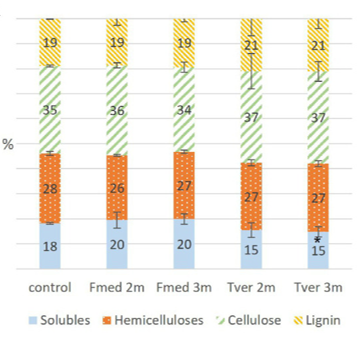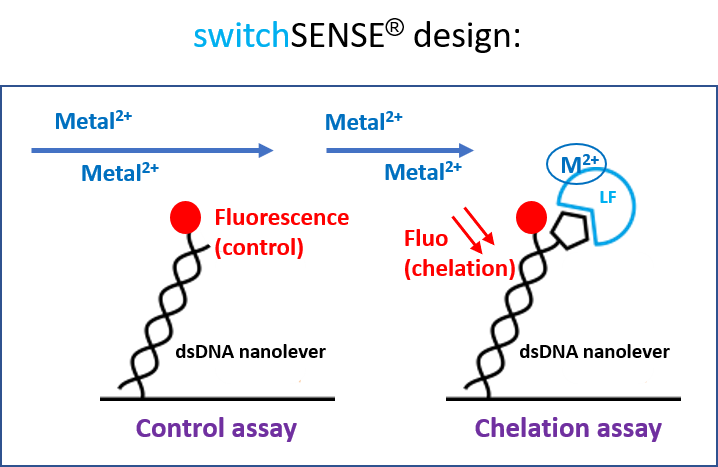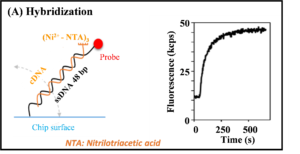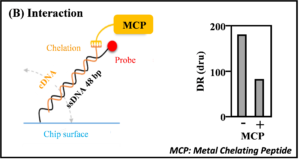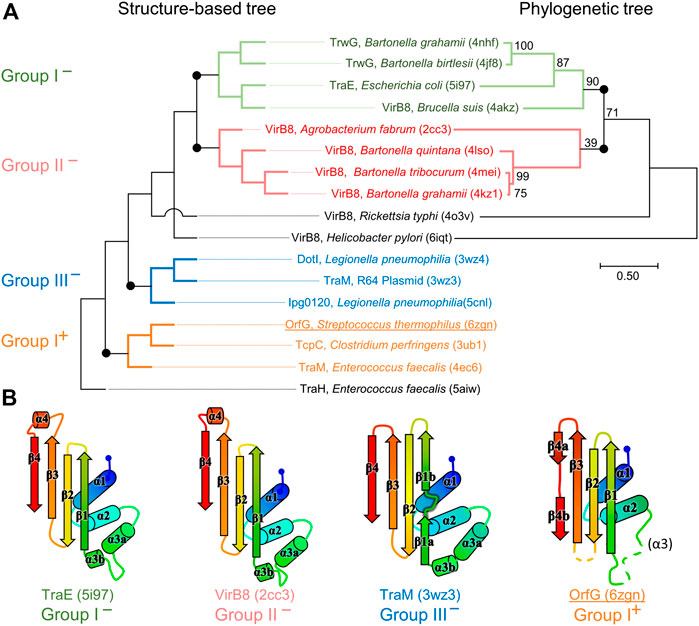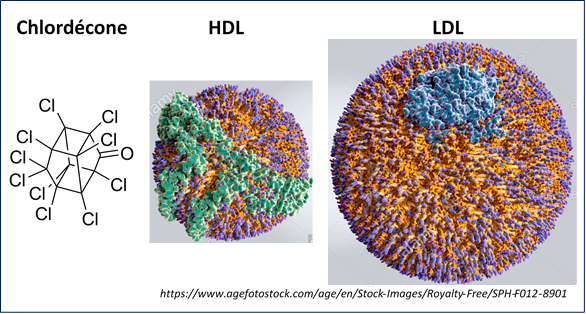
ASIA Platform: Functional and Structural Approaches to Cellular Interactions
News
16 February 2024
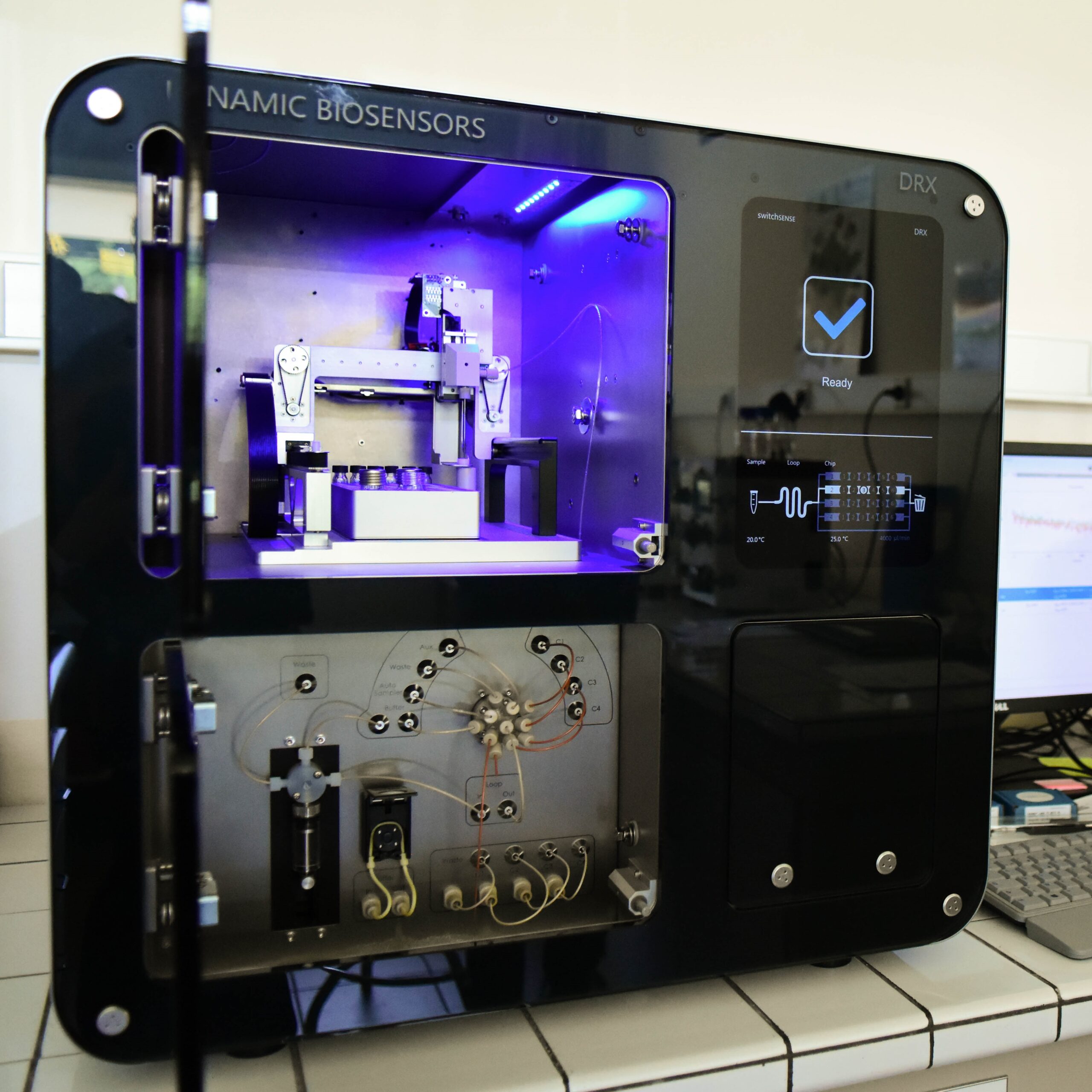
Video
Filming of a video presenting the ASIA platform
A video presenting the ASIA platform was filmed on 19 and 20 October. The operational manager and functional manager warmly invite you to watch this video in the presentation section of the ASIA platform website or on ULTV :
October 06, 2023

ORION
We're the talk of the town!
As part of Research Week and the ORION program, the A2F cluster’s various research support structures, including the ASIA platform, organized a presentation and round table discussion on research careers. A number of interested students attended a presentation of the platforms and the various associated professions (mainly ITRF). They were also able to talk to the speakers and visit ASIA.
22 May 2023
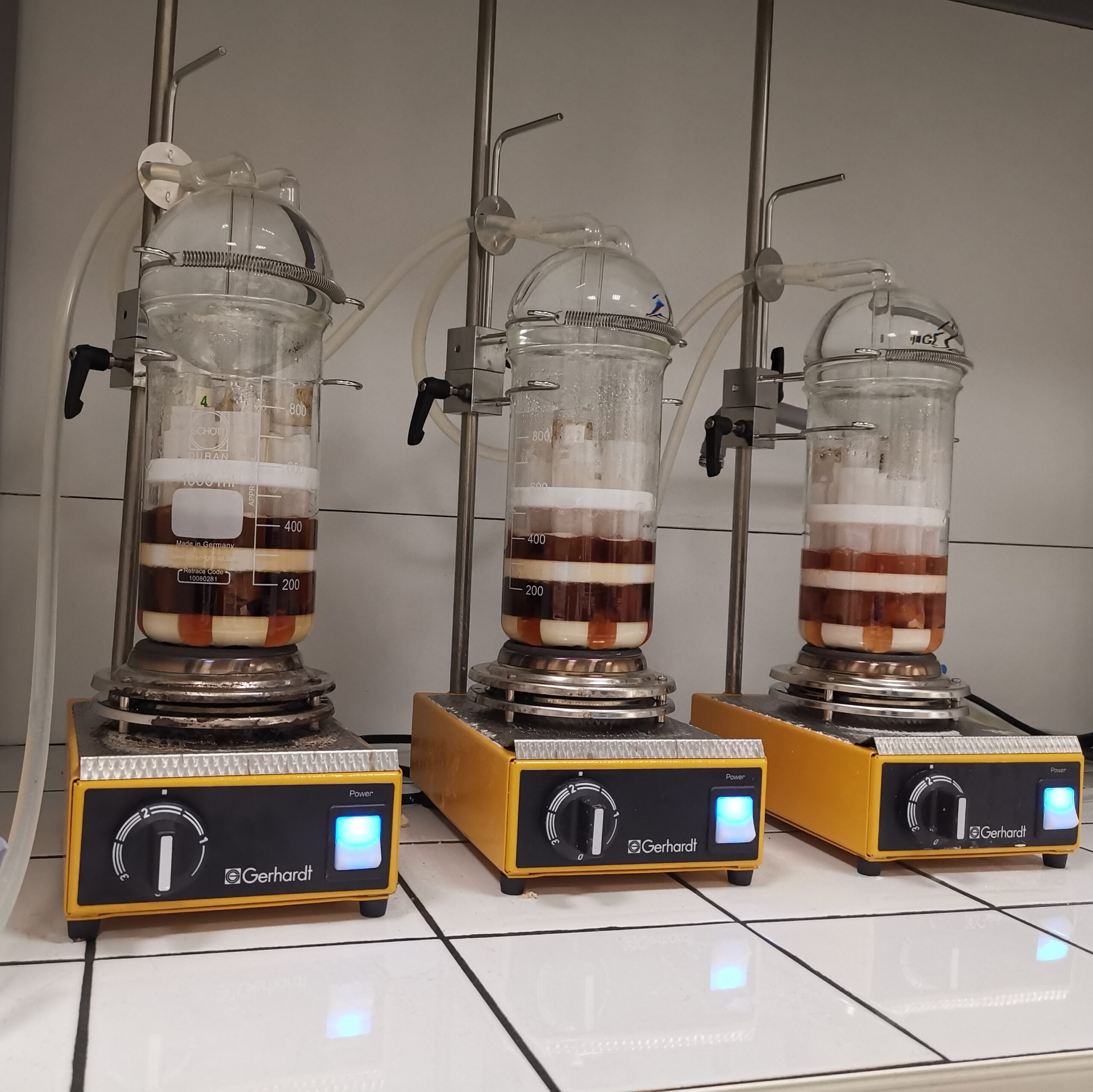
Publication
Degradation of vine wood by Fomitiporia mediterranea
PUBLICATION: Grapevine wood rot by Fomitiporia mediterranea.
Tinder or white rot sometimes observed in grapevine wood is a characteristic symptom of Esca, one of the major wood diseases of grapevines. The fungus Fomitiporia mediterranea is the major fungal species in Europe involved in this rot.
Researchers from UMR 1136 IAM in Nancy, in collaboration with UMR-A 1131 SVQV and UPR-3991 LVBE in Colmar, have attempted to understand the mechanisms that allow Fomitiporia mediterranea to degrade wood, and in particular vine wood. They highlighted a simultaneous degradation pattern of grapevine wood by the fungus and of beech wood used as a reference. Concerning the specific degradation of vine wood, the study showed a relative overproduction of oxidoreductases by Fomitiporia mediterranea. These enzymes are notably involved in the degradation of lignin. Only a few differences in the enzymes active on carbohydrates could be identified.
These results could partially explain the adaptation of Fomitiporia mediterranea to the structural composition of grapevine wood compared to other wood species, and suggest that other biotic and abiotic factors should be taken into account to fully understand the potential adaptation of this fungus to its ecological niche.
The Fibrebag technology available on the ASIA platform was used to determine the polymer content of the wood structure as well as the proportion of extractives in the different samples.
The results were published in Frontiers in Plant Science [Schilling, M., Maia-Grondard, A., Baltenweck, R., Robert, E., Hugueney, P., Bertsch, C., Farine, S., & Gelhaye, E. (2022). Wood degradation by Fomitiporia mediterranea M. Fischer: Physiologic, metabolomic and proteomic approaches. Frontiers in Plant Science, 13, 988709. https://doi.org/10.3389/fpls.2022.988709].
12 May 2023

Publication
Plant polygalacturonases to adjust cell wall pectins
PUBLICATION: PLANT POLYGALACTURONASES TO ADJUST CELL WALL PECTINS
Plant cell walls are composed of a network of pectins whose fine tuning by polygalacturonases plays a key role in modulating the chemistry and mechanics of the cell wall, which has an impact on plant development.
Researchers from UMRT INRAE 1158 BioEcoAgro – BIOPI Biologie des Plantes et Innovation, University of Picardie (Amiens), in collaboration with numerous research teams, present the first two crystal structures of Arabidopsis thaliana polygalacturonases, PGLR and ADPG2, which are co-expressed during root development.
The UMR 1136 IAM (University of Lorraine) collaborated in this work and used the switchSENSE technology available on the ASIA platform to determine the enzyme-substrate dynamics.
The results have just been published in The Plant Cell [Safran J., Tabi W., Ung V., Lemaire A., Habrylo O., Bouckaert J., Rouffle M., Voxeur A., Pongrac P., Bassard S., Molinié R., Fontaine J.-X., Pilard S., Pau-Roblot C., Bonnin E., Larsen D.S., Morel-Rouhier M., Girardet J.M., Lefebvre V., Sénéchal F., Mercadante D., & Pelloux J. (2023). Differences in the crystal structure of plant polygalacturonases specify enzymes’ dynamics and processivities to fine-tune cell wall pectins. https://doi.org/10.1101/2022.06.22.497136].
September 05, 2022

Partnership
ASIA partner of the ORION program
Since November 25, 2021, the ORION program has launched a call for applications to fund TPs of excellence with the aim of facilitating access to cutting-edge experimental platforms for Master’s students on Lorraine campuses and engineering students. Interview with Céline Cakir-Kiefer : http://factuel.univ-lorraine.fr/node/20025
May 11, 2022

Publication
Antioxidant properties of mare lactoferrin from Kazakhstan
PUBLICATION: Antioxidant properties of mare lactoferrin from Kazakhstan
Lactoferrin is a soluble protein present in milk and is known for its antimicrobial properties (antibacterial, antifungal, antiviral, etc.) as well as for its role in immune defence. In collaboration with researchers from the UR AFPA and researchers from the Faculty of Biology and Biotechnology in Almaty (Kazakhstan), we explored the antioxidant properties of lactoferrin purified from Kazakh mares’ milk by determining its ability to chelate oxidising metal ions such as zinc, iron and copper using the switchSENSE® technology available on the ASIA platform.
The results have just been published in LWT Food Science and Technology :
Narmuratova Z., Hentati F., Girardet J.M., Narmuratova M., & Cakir-Kiefer C. (2022). Equine lactoferrin: Antioxidant properties related to divalent metal chelation. LWT Food Science and Technology, 161, 113426 [doi.org/10.1016/j.lwt.2022.113426].
January 19, 2022

Seminar
switchSENSE seminar announcement: new HELIX
You will find attached the announcement of a seminar on March 8 by Amandine Gontier from Dynamic Biosensors (Munich) who will present the new HELIX equipment based on the original switchSENSE technology for the study of biomolecular interactions in real time and the conformation of proteins.
October 22, 2021
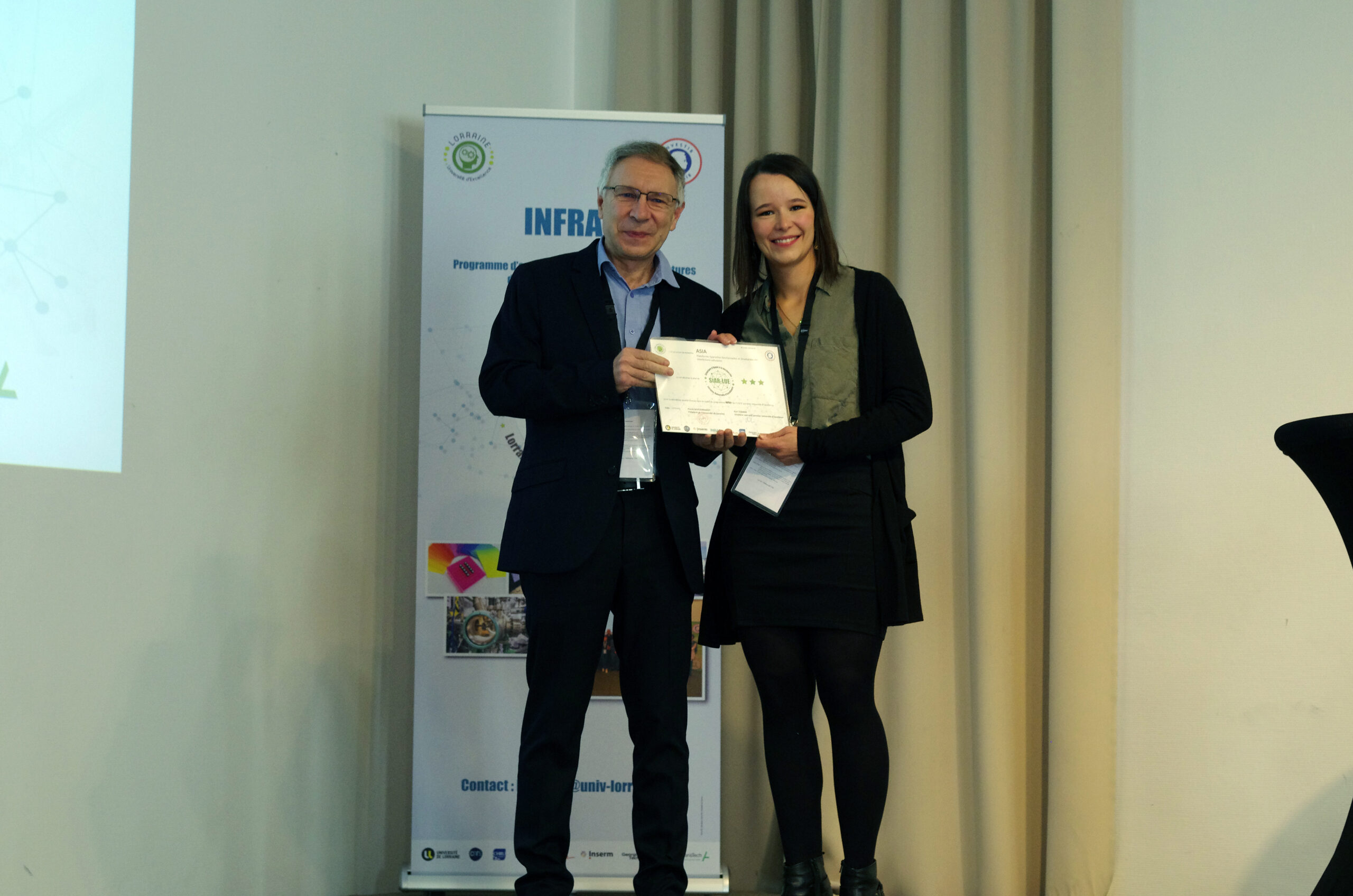
Ceremony
ASIA at LUE's INFRA+ Graduation
ASIA at the graduation ceremony of LUE’s INFRA+ program
During the ceremony organized on October 15 at the Abbaye des Prémontrés in Pont-à-Mousson on the occasion of the perpetuation of the I-site Lorraine University of Excellence (LUE), the StAR-LUE labeling diplomas of the INFRA+ program were awarded.
The 24 structures awarded the label for the years 2020-2021 were honored one after the other in the presence of Pierre Mutzenhardt, President of the University of Lorraine, Karl Tombre, Executive Director of Lorraine University of Excellence and Erwin Dreyer, Head of the INFRA+ program.
On this occasion, the ASIA platform as well as two other accredited structures were asked to present to the audience a feedback on the implementation of the Quality Approach.
Jean-Michel Girardet and Emilie Robert, operational and functional managers of the ASIA platform presented the platform and reported on the implementation of the Quality Approach since the call for expressions of interest (AMI 2018) until the first results.
This event was an opportunity to meet and exchange with colleagues also involved in the implementation of a Quality Approach.
October 13, 2021

Communication
ASIA participated in the switchSENSE usermeeting
Biophysical Method and switchSENSE User Meeting – Munich Sep 15-17, 2021
Jean-Michel Girardet participated to the last User Meeting organized by Dynamic Biosensors, the company developing the switchSENSE technology. He presented in about 30 minutes the last results obtained with the switchSENSE of the ASIA platform concerning (i) the study of the interaction between glutathione transferases (GST) of the Ure2p family and the transcription elongation factor EF1B (project of Mélanie Morel-Rouhier, UMR1136 IAM) and (ii) the study of the uptake by human plasma lipoproteins HDL and LDL of chlordecone, an organochlorine pesticide (project of Céline Cakir, UR AFPA). This seminar was also a convivial moment of exchange between the users or future users concerning their experience of this rather recent technology.
July 22, 2021
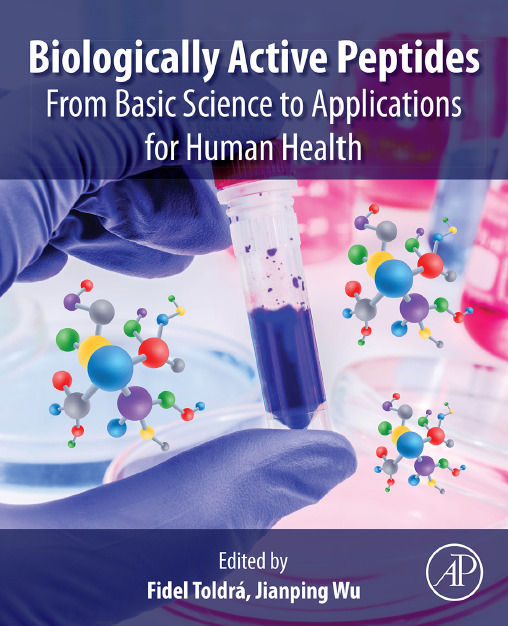
Publication
Book on source proteins of bioactive peptides
Publication of a book chapter on food proteins as sources of bioactive peptides
Bio-functionality of food peptides binding minerals: State of the art and new developments
In collaboration with colleagues from LRGP, CITHEFOR, University of Antioquia (Medellin, Colombia), LIBio, LCPM, L2CM and STLO (INRAE Rennes), ASIA participated in the writing of a book chapter entitled “Application in Nutrition: Mineral-Binding” and written by S. El Hajj, T. Sepúlveda-Rincon, K. Selmeczi, C. Paris, T. Giraud, G. Csire, L. Stefan, J-M. Girardet, S. Desobry, S. Bouhallab, L. Muhr, C. Gaucher, and L. Canabady-Rochelle. ASIA brought its expertise in the original study of peptide/mineral interactions in real time using the switchSENSE technology.
This publication is part of the thesis of Sarah El Hajj directed by Laetitia Canabady-Rochelle (LRGP) and Caroline Gaucher (CITHEFOR), and in connection with the “metal chelating peptides” consortium of IMPACT Biomolecules (LUE project 2017-2021).
Publication reference:
July 16, 2021
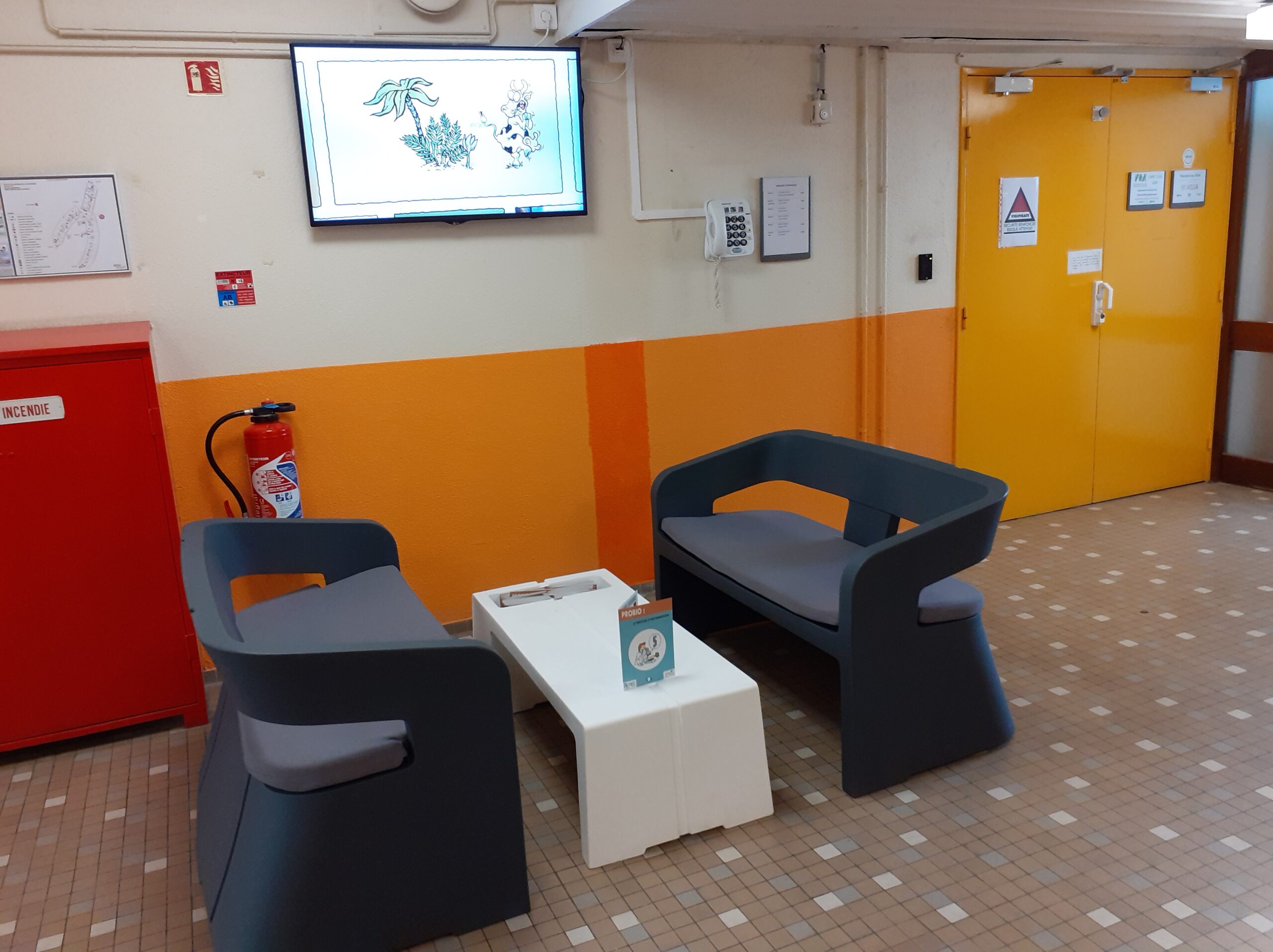
Mediation
Installation of three television sets
Thanks to funding from the CSTI+ ProBio program, the ASIA platform now broadcasts information throughout the Aiguillettes campus. Indeed, three televisions have been acquired, two of which are installed on the 3rd and 6th floors of entrance 1B of the Faculty of Science and Technology. These two sets broadcast a flow of information concerning the different structures identical to eight other sets on the campus, as follows
– Administration building, entrance hall
– Graduate building, high level atrium
– Graduate building, atrium lower level
– Poincaré building, main entrance hall
– BU, Reception
– ATELA building, main entrance hall
– AIPL building, main entrance hall
– SUMMPS, Velodrome site, entrance hall
– IAM Laboratory, Building 1B, 3rd entrance hall
– IAM Laboratory/ASIA Platform, Building 1B, 6th entrance hall
These televisions were commissioned on July 13, 2021 and will be used to promote the ASIA platform more widely. The last TV set installed in the room where the switchSENSE is located will be used to broadcast explanatory videos about the platform’s devices during visits organized for the training of students and PhD students, during the reception of new users or during the reception of high school students and the general public within the framework of the scientific mediation action.
June 16, 2021

Communication
ASIA participated to the ProteinLorraine network
On Monday, May 31, 2021 the ASIA platform participated in the first day of the scientific network ProteinLorraine. This new network created in 2019 gathers research entities distributed in 6 scientific poles of the University of Lorraine. The theme of the day was “Biochemical, biophysical and structural approaches to proteins in Lorraine”. 15 presentations were proposed to the audience in distanciel because of the Covid 19 pandemic. 10 laboratories and 4 technological platforms were represented.
The objective of knowing or rediscovering the different activities and themes around proteins in Lorraine was reached for this first day.
Jean-Michel Girardet and Emilie Robert intervened at the end of the morning to make discover the ASIA platform and some examples of applications of the devices to this public specialist of proteins, more than 90 people attended this presentation. The interest was strong and the platform staff hopes that this initiative will allow it to be more widely known.
April 08, 2021
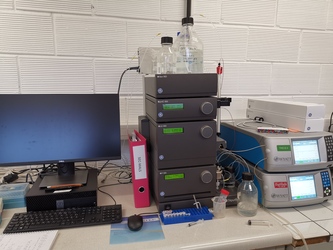
Publication
Study of OrfG, a T4SS component of ICESt3
STRUCTURAL AND BIOCHIMICAL ANALYSIS OF ORFG PROTEIN, A TYPE IV SECRETORY SYSTEM (T4SS) COMPONENT OF THE INTEGRATIVE AND CONJUGATED ELEMENT ICESt3 OF STREPTOCOCCUS THERMOPHILUS.
Horizontal gene transfer plays an essential role in gene acquisition and contributes in particular to the dissemination of antibiotic resistance genes, which today constitutes a public health threat of exceptional magnitude at the global level. A major mechanism of horizontal transfer is bacterial conjugation, which ensures the transmission of mobile genetic elements (MGEs), including ECIs, from one bacterium to another by physical contact. The transfer of EGMs occurs through a multi-protein complex assembled in the bacterial envelope called the Conjugative Type IV Secretion System (Conj-T4SS). In this study, a collaboration between DynAMic and CRM2 laboratories, we have implemented biochemical and structural approaches to characterize the OrfG protein. This protein is a central component of the ICESt3 Conj-T4SS of the Gram-positive bacterium Streptococcus thermophilus. Little information is available to date on the Conj-T4SS of Gram positive bacteria. The crystallographic study of OrfG has shown that this protein has a similar structure to proteins belonging to the VirB8 family despite very low sequence identities. How can proteins with so few sequence identities present similar 3D structures? This question remains unanswered to this day. Through an extensive structural analysis coupled with a phylogenetic study, we have identified several structural classes of these proteins distributed separately between Gram-negative and Gram-positive bacteria. This suggests significant differences in the modes of function of Conj-T4SS between these bacteria. By biochemical analyses, we have shown that the OrfG protein forms hexamers in solution, a novel property for this protein family. This work has, in particular, used the SEC-MALS-RI technology of the ASIA platform.
The results have just been published in Frontiers in Molecular Biosciences: [Cappele J., Mohamad-Ali A., Leblond-Bourget N., Mathiot S., Dhalleine T., Payot S., Savko M., Didierjean C., Favier F. & Douzi B. (2021). Structural and biochemical analysis of OrfG: the VirB8-like component of the conjugative type IV secretion system of ICESt3 from Streptococcus thermophilus, doi:10.3389/fmolb.2021.642606. eCollection 2021].
March 15, 2021

StAR-LUE labeling
The ASIA platform obtains the StAR-LUE label
The work of the staff of the ASIA platform, accompanied in their approach by Mr. Laurent Perilhon of the DAPEQ, for the labeling of the ASIA platform, has borne fruit. Indeed, following its evaluation last February, the platform obtained an excellent appreciation leading to the attribution of the StAR-LUE *** label by the Lorraine University of Excellence Executive Committee, as attested by the attached document dated March 5th:
February 08, 2021

Quality assessment
Evaluation of the ASIA platform for the StAR-LUE label
On Thursday 04 February 2021 the ASIA Platform was evaluated by Virginie Marchand and Julie Gonnet of the UMS IBSLor in order to obtain the StAR-LUE INFRA+ label.
The evaluation day took place in the presence of the platform’s operational and functional managers.
This evaluation finalizes a long work of implementation of the quality approach on this still young platform.
February 08, 2021
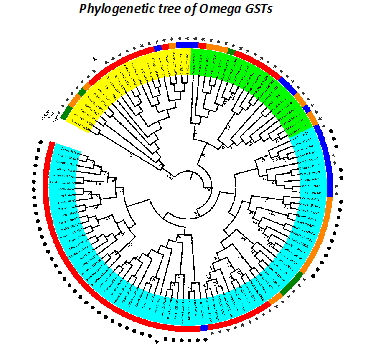
Publication
Phylogenetic diversity of fungus GSTs
DIVERSITY OF OMEGA GLUTATHIONE TRANSFERASES IN MUSHROOM-FORMING FUNGI
The Omega class of glutathione transferases (GSTs) forms a distinct class within the cytosolic GST superfamily because most of them possess a catalytic cysteine residue. This study re-assesses the phylogeny and the classification of GSTOs based on 240 genomes of mushroom-forming fungi (Agaricomycetes). The analysis leads to a new classification in which the fungal GSTOs are divided into two Types A and B. The catalytic residue of Type-A is either cysteine or serine, while that of Type-B is cysteine. Transcriptomic data show that Type-A GSTOs are constitutive enzymes while Type-B are inducible ones. The crystallographic analysis reveals substantial structural differences between the two types while they have similar biochemical profiles. Additionally, these enzymes have the ability to bind antioxidant molecules such as wood polyphenols in two possible binding sites as observed from X-ray structures. The multiplication of GSTOs could allow fungal organisms to adapt more easily to new environments. This work has notably used the switchSENSE technology of the ASIA platform.
The results have just been published: [Perrot T., Schwartz M., Deroy A., Girardet J.M., Kohler A., Morel-Rouhier M., Favier F., Gelhaye E. & Didierjean C. (2021). Diversity of Omega Glutathione Transferases in mushroom-forming fungi revealed by phylogenetic, transcriptomic, biochemical and structural approaches. Fungal Genetics and Biology, 148, 103506].
January 05, 2021
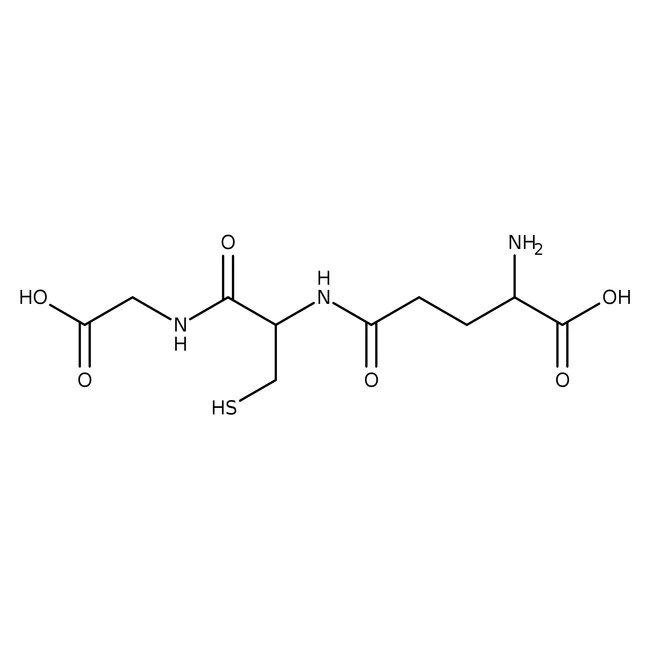
Publication
An elongation factor involved in redox regulation
IMPLICATION OF A TRANSLATION ELONGATION FACTOR IN REDOX REGULATION
In the fungus Phanerochaete chrysosporium, the eEF1Bγ subunit of the EF1 elongation factor is known to act as a scaffolding protein stabilizing the EF1 complex. Thanks in particular to thermodynamic (ITC) and kinetic (switchSENSE) approaches carried out on the ASIA platform, researchers from the UMR IAM have shown that the subunit has additional characteristics : It is active as a glutathione transferase in the presence of reduced glutathione (A), it changes conformation upon binding of oxidized glutathione (B), and the oxidized glutathione promotes the interaction between eEF1Bγ and glutathione transferase Ure2p (C), suggesting a presumed redox regulation of the elongation factor.
The results have just been published in The FEBS Journal [Bchini R., Girardet J.M., Sormani R., Gelhaye E. & Morel-Rouhier M. (2020). Oxidized glutathione promotes association between Eukaryotic Translation Elongation Factor 1Bγ and Ure2p glutathione transferase from Phanerochaete chrysosporium. https://doi.org/10.1111/febs.15614].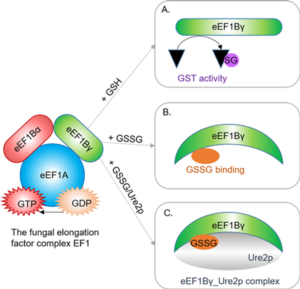
October 16, 2020

Publication
Highlighting the physiological role of a BolA protein
EVIDENCE OF THE PHYSIOLOGICAL ROLE OF A BACTERIAL PROTEIN TYPE BolA
Sinorhizobium meliloti is a nitrogen-fixing bacterium that forms symbiotic nodules with the legume Medicago truncatula. This bacterium has a BolA-type protein called YrbA, whose physiological role is unknown. In organisms where BolA proteins and monothiol glutaredoxins (Grxs) are present, they contribute to the regulation of iron homeostasis and also to the maturation of proteins with an iron-sulfur center.
Thanks in particular to thermodynamic (ITC) and kinetic (switchSENSE) approaches carried out on the ASIA platform, researchers from the UMR IAM, UMR CRM2 and ISA of Sophia Antipolis were able to show that YrbA coordinates various divalent metal ions (iron, cobalt, nickel, copper and zinc) and has the ability to form heterodimers with the only glutaredoxin monothiol (Grx2) present in this species. This study helps to clarify the physiological role of BolA-type proteins in bacteria.
The results have just been published in Bioscience Reports [Roret T., Alloing G., Girardet J.M., Perrot T., Dhalleine T., Couturier J., Frendo P., Didierjean C. & Rouhier N.]. (2020). Sinorhizobium meliloti YrbA binds divalent metal cations using two conserved histidines. Biosci. Reports, 40, BSR20202956].
October 15, 2020
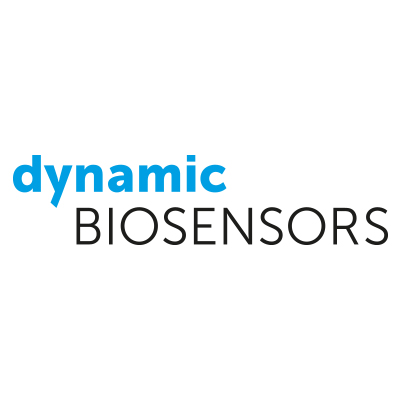
Communication
Presentation of results obtained on ASIA in New York City
Dynamic Biosensors, which markets switchSENSE, presented results obtained on the ASIA platform at Cold Spring Harbor Labs on September 14, 2020 in a webinar.
The Cold Spring Harbor Labs is a private, non-profit institution ranked among the world’s leading basic research institutions in molecular biology and genetics. It has been in existence since 1890 and is located in New York City.
The ASIA platform and the DynAMic laboratory are making headlines across the Atlantic!
The results presented were published in July 2020:
September 29, 2020

Directory
ASIA referenced in the Plug in Labs Lorraine directory
Within the framework of the I-SITE Lorraine University of Excellence and more precisely of the Infra+ program, the Lorraine research skills portal “Plug in labs Lorraine” is now online!
This portal is a digital directory which will present the offer of the infrastructures and research units of the Lorraine site (University of Lorraine, CNRS, INRAE, Inria, Inserm, CHRU of Nancy) in terms of research, scientific and technical skills, equipment, technologies and engineering. It will orient academic and socio-economic players towards the various skills to encourage the emergence of collaborative projects and high-tech services. It will present the skills, equipment, technologies and certain patents from the research infrastructures and research units in the form of a fact sheet. The search can be done by free keywords, according to the main themes of the Lorraine site or by type of service sought (patent, service …). In short, Plug in labs Lorraine will map skills and promote scientific expertise in order to encourage exchanges with socio-economic players.
For the moment, only research infrastructures (platforms) are presented on Plug in labs Lorraine.
The presentation of the Research Units is being finalized and will be accessible on the portal by the end of the year.
Find ASIA in the recently available Lorraine directory:
https://pluginlabs.univ-lorraine.fr/fr/results/keywords/ASIA
September 25, 2020
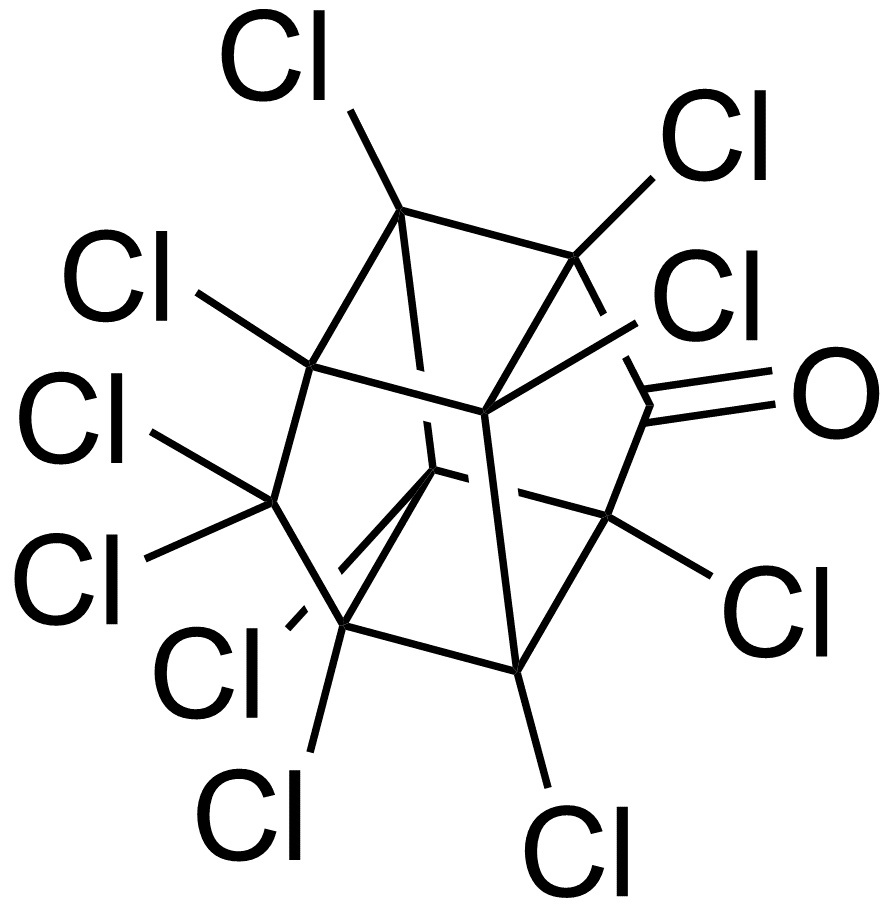
Publication
Study of chlordecone binding to lipoproteins
REAL-TIME IN VITRO STUDY OF THE BINDING OF A PESTICIDE (CHLORDECONE) TO HUMAN PLASMA LIPOPROTEINS
Chlordecone is a chlorinated persistent organic pollutant (POP) that is still found in soils despite its ban in 1993, particularly in banana plantations in the West Indies. Once absorbed, it accumulates in the liver while its metabolite, chlordecol, is found instead in bile. The contamination can have a serious impact on health, including an increased incidence of prostate cancer and neurodevelopmental disorders.
Thanks to the innovative switchSENSE® technology available on ASIA, URAFPA researchers were able to show for the first time that chlordecone binds specifically to plasma LDL lipoproteins with high affinity (KD of 1 µM), but does not bind to HDL. The opposite is observed for chlordecol. This work thus provides a better understanding of how chlordecone and chlordecol are differently transported in the bloodstream to reach specific tissue targets.
The results have just been published in Environmental Toxicology and Pharmacology [Delannoy M., Girardet J.M., Djelti F., Yen F.T.]. & Cakir-Kiefer C. (2020). Affinity of chlordecone and chlordecol for human serum lipoproteins. Environ. Toxicol. Pharmacol. 80, 103486. doi.org/10.1016/j.etap.2020.103486].
https://www.agefotostock.com/age/en/Stock-Images/Royalty-Free/SPH-F012-8901
July 20, 2020
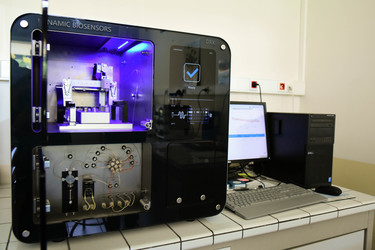
Publication
Study of the gene regulation of kinamycins
REAL-TIME IN VITRO STUDY OF THE GENE REGULATION OF THE PRODUCTION OF KINAMYCINS, A FAMILY OF ANTIBIOTICS PRODUCED BY THE BACTERIUM STREPTOMYCES AMBOFACIENS.
A team from UMR UL-INRAE 1128 DynAMic is interested in the regulation of kinamycin biosynthesis in Streptomyces ambofaciens bacteria. Among the various transcription factors involved in this regulation, the AlpZ protein is a major player that negatively controls the kinamycin production regulation cascade. Its action is modulated by a signalling molecule of as yet unknown nature. The binding of AlpZ to the promoter sequence of its target genes and its release in the presence of the signal molecule were characterized in real time using for the first time switchSENSE® technology available on the ASIA platform. The results have just been published in the journal Frontiers in Microbiology [Vicente C.M., Girardet J.M., Hôtel L. & Aigle B. (2020). Molecular dynamics to elucidate the DNA-binding activity of AlpZ, a member of the gamma-butyrolactone receptor family in S. ambofaciens. Front. Microbiol, 11.:1255. doi: 10.3389/fmicb.2020.01255].
June 5, 2020
Works
Progress of work on the platform's future premises

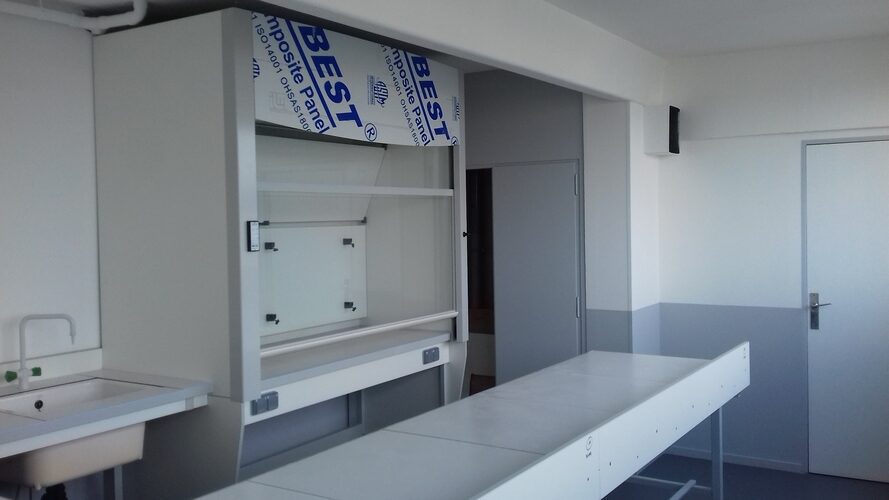

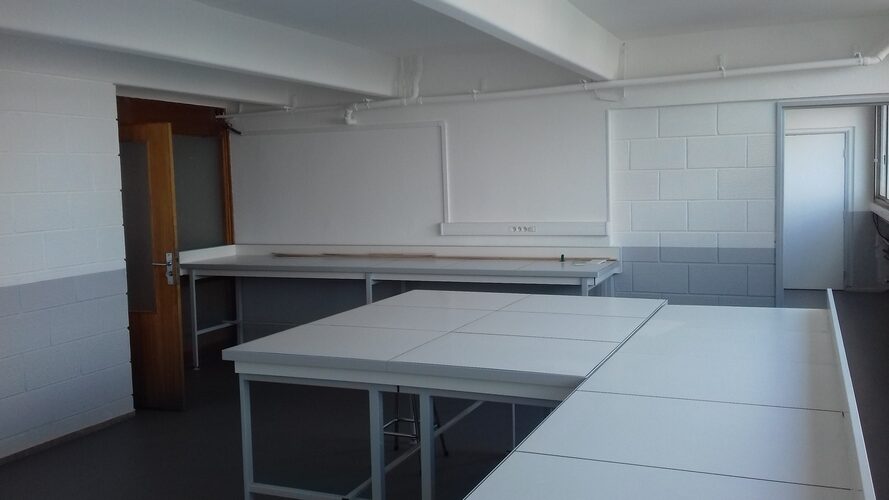

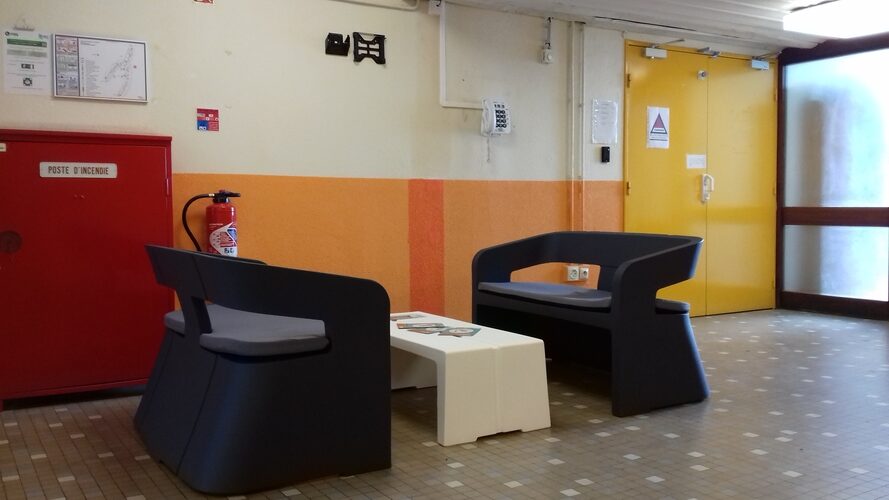
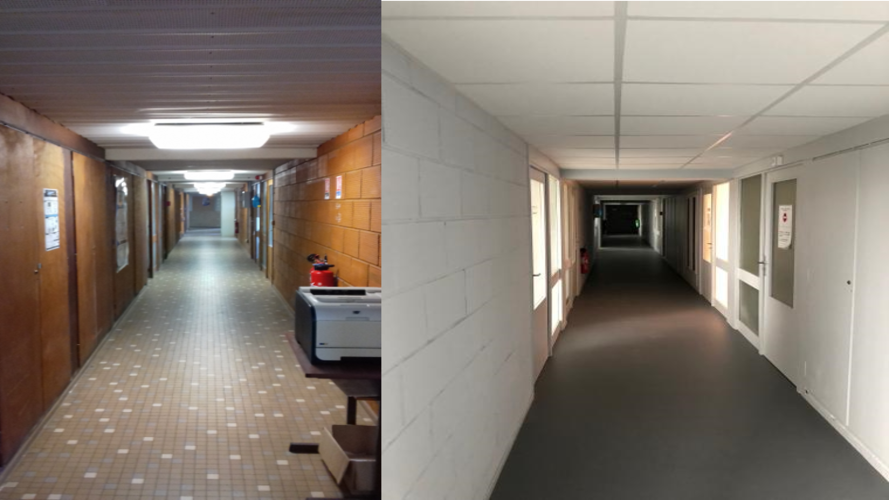
June 2, 2020

Event
Coronavirus crisis and deconfinement of the ASIA platform
Since 18 May 2020 the ASIA platform equipment has been back in service.
In strict compliance with the barrier measures in force at the University of Lorraine, the ASIA platform is working to relaunch scientific research at the Faculty of Science and Technology of Nancy.
Nevertheless, teleworking remains the norm for all activities that can be carried out remotely.
The operational and functional managers are at your disposal to satisfy your requests for availability and services in complete security.
Take care of yourself and your families!
April 23, 2020

Event
Read the Coronavirus Crisis and ASIA Platform Containment
Since March 16, 2020 teleworking is the norm for ASIA platform staff.
The opportunity to create a functional and attractive site for the new research support structure:
ASIA and its staff made a point of supporting the caregivers during this ordeal and donated their stock of single-use gloves and hydroalcoholic gel to the Médipôle de Gentilly and the Louis Pasteur Santé polyclinic.
The ASIA platform is obviously closed for the moment.
Take care of yourself and your families!
Sars CoV-2 coronavirus under the microscope, February 27, 2020. (NATIONAL INSTITUTES OF HEALTH / AFP)

